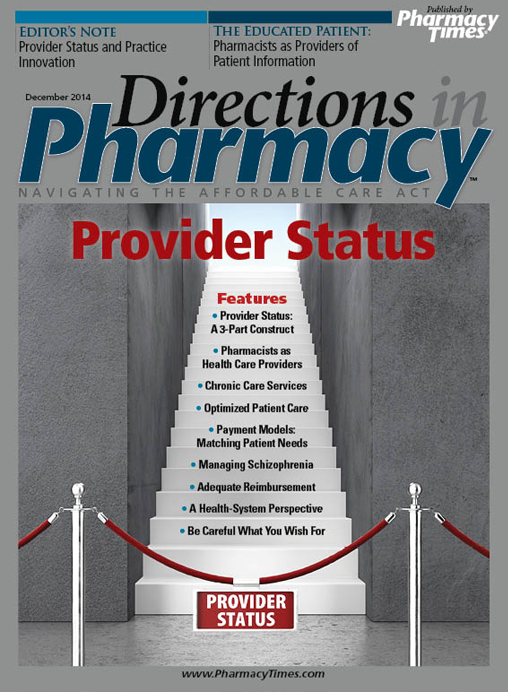Publication
Article
Pharmacy Practice in Focus: Oncology
HR 4190: Addressing Increased Demand for Chronic Care Services
Author(s):
Our aging population will require continuous medication management for chronic conditions.

Our aging population will require continuous medication management for chronic conditions.
If you have been keeping up with the policy updates surrounding the profession of pharmacy, you have likely come across news about HR 4190, which would amend title XVIII of the Social Security Act to cover pharmacist services. Commonly referred to as the “provider status” bill, this legislation has gained traction since its introduction in March 2014, with support from more than 100 members of Congress. It is anticipated that a companion bill will be introduced in the Senate next year. Currently, the Centers for Medicare & Medicaid Services grants provider status to physicians, chiropractors, clinical social workers, nutritionists, clinical psychologists and other health care professionals, which allows these providers to bill health insurance for their services. HR 4190 seeks Medicare coverage for pharmacist’s services in medically underserved areas. The implications of this bill have the potential to significantly impact the practice of pharmacy through advanced scope of practice and an expansion of payment mechanisms. What does that mean for you and how would practice change as result of the passage of legislation such as this?
A 2010 study reported that on average, a physician spends 20.8 minutes in a face-to-face encounter with a patient.1 With the fee-for-service payment model still prevalent, providers balance the challenge of obtaining an accurate medical history, completing an assessment, encouraging behavior change, providing education, and documenting the patient encounter within a short time frame, all while trying to maintain a financially viable practice. This is increasingly a challenge for an already bursting-at-theseams practice model contending with the health care needs of our aging baby boomer generation. We expect baby boomers, born between 1946 and 1964, to appreciate a longer life expectancy than any generation that preceded them. By 2030, there will be more than 70 million Americans older than 65 years.2 The number of baby boomers with multiple chronic conditions is expected to grow to nearly 37 million by 2030. By 2030, more than 6 of every 10 individuals of the baby boomer generation will be managing more than one chronic condition.3 Furthermore, data trends indicate that 1 out of every 4 baby boomers (14 million) will be living with diabetes mellitus and more than 21 million will be considered obese.4 With a notable rise of health care demands in this segment alone, there is a critical need for an increase in the creation and assembly of health care teams to address the demand, uphold quality, and improve patient access to care.
Each state’s pharmacy practice act authorizes pharmacists to deliver patient care services that may include immunizations, diabetes education, medication reconciliation, and home visits, but there are other professions that also deliver these services to patients. What makes our profession different and why should we pursue legislation to cover our services? The reason is that a pharmacist’s training goes beyond medication reconciliation or the delivery of preventive services. Pharmacists are best qualified to work with complex medication regimens, systematically reviewing medications for effectiveness, safety, and appropriateness considering the indication. The evaluation of the medication regimen is best completed through collaboration among the prescriber, other members of the health care team, and direct interaction with the patient. Patients taking multiple medications may benefit from additional education and oversight, which are often omitted during a routine physician visit.
To date, there have been limited payment mechanisms that financially support pharmacists in these roles. If enacted, HR 4190 could open up opportunities for pharmacists to offer and deliver these services and financially justify the effort. With nearly 75 cents per health care dollar spent on the treatment of chronic disease states, even modest improvements by the health care team involved in the management of chronic disease states focusing on appropriate medication use would result in significant health cost savings.5
Attaining coverage for services through HR 4190 will impact all types of practice settings. To maximize patient encounters, pharmacists across all segments of health care, including community, chronic care, and health-system practice, must be ready to intercept medication lists at every transition point to ensure that patients clearly understand and have access to the appropriate medications. When considering the geriatric population specifically, pharmacist involvement with interdisciplinary care teams can be beneficial in reducing the number of drug-related problems occurring at times of transition. Nearly one-third of hospitalizations and one-half of skilled nursing facility admissions have been associated with medication- related problems.5 Pharmacists’ ability to detect medication-related problems and recommend appropriate treatment can ensure a smooth transition for the patient across the continuum of care. Moreover, the reduction in or prevention of medication- related problems will allow a patient to remain in an independent living setting longer. Recognition and coverage for pharmacist-provided services will incentivize pharmacists and pharmacist employers to implement, expand, and integrate patient care services into a collaborative care delivery model. Pharmacists should employ strategies of enhanced communication using all technology available, without eliminating the value of face-to-face interaction.
When it comes to evaluating potential for cost savings as a result of adding a pharmacist to the care team, we cannot promise that the addition of these services will result in decreased drug spending. If pharmacists are involved, it should be expected that drug costs will be increased to ensure that patients are adherent to quality, individualized regimens that will offer optimal health outcomes. The Congressional Budget Office estimates that in the Medicare program, a 1% increase in prescription drug use would result in a decrease of total medication spending by approximately one-fifth of 1%.6 It is a true possibility that passage of HR 4190 will result in the opportunity to deliver pharmacy care that will offset total health care costs. In order to improve health care delivery to address the growing number of patients with chronic conditions, creative solutions are needed for enhancing health-system and community-based collaboration and strengthening outpatient services. With increased longevity and an increasing number of patients managing chronic conditions, our patient population is going to require continuous medication management across all practice settings. Relying on pharmacists to address complex medication issues can be one solution to meeting the rising demand for patient care.
Ashley Branham, PharmD, BCACP, is director of clinical services at Moose Pharmacy in Concord, North Carolina. Branham received her PharmD from Campbell University. She completed a community pharmacy residency at the UNC Eshelman School of Pharmacy and Moose Professional Pharmacy in Concord. She also completed a PGY2 community pharmacy residency with a focus in academia with the UNC Eshelman School of Pharmacy and Moose Professional Pharmacy in 2010. Branham is involved with the implementation and enhancement of clinical activities. She is currently a preceptor for student pharmacists completing advanced pharmacy practice rotations with the UNC Eshelman School of Pharmacy.
References
- National Ambulatory Medical Care Survey: 2010 Summary Tables. Centers for Disease Control and Prevention website. www.cdc.gov/nchs/data/ahcd/namcs_summary/2010_namcs_web_tables.pdf. Accessed on October 5, 2014.
- Centers for Disease Control and Prevention. The State of Aging and Health in America 2013. Atlanta, GA: Centers for Disease Control and Prevention; 2013. www.cdc.gov/aging/pdf/state-aging-health-in-america-2013.pdf.
- Wolff JL, Starfield B, Anderson G. Prevalence, expenditures, and complications of multiple chronic conditions in the elderly. Arch Intern Med. 2002;162:2269-2276.
- FCG projections based on National Center for Chronic Disease Prevention and Health Promotion. National Diabetes Surveillance System.
- Partnership to Fight Chronic Disease. 2009 Almanac of Chronic Disease. www.fightchronicdisease.org/sites/fightchronicdisease.org/files/docs/2009AlmanacofChronicDisease_updated81009.pdf. Accessed October 14, 2014.
- Congressional Budget Office. Offsetting effects of prescription drug use on Medicare’s spending for medical services. www.cbo.gov/sites/default/files/cbofiles/attachments/43741-MedicalOffsets-11-29-12.pdf. Published November 2012. Accessed October 14, 2014.







